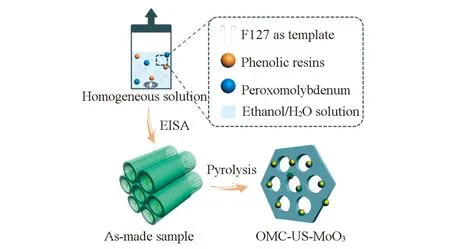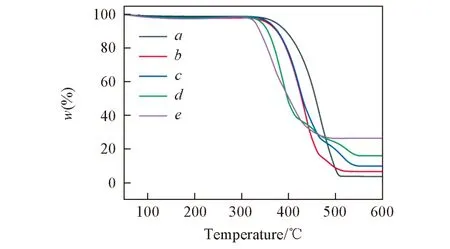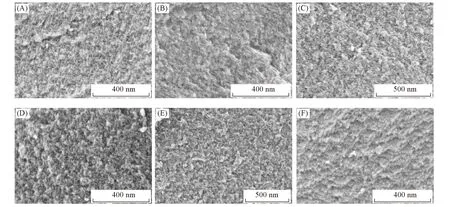原位限域生长策略制备有序介孔碳负载的超小MoO3纳米颗粒
王常耀,王 帅,段林林,朱晓航,张兴淼,李 伟
(复旦大学化学系,上海 200433)
Epoxides,an important industrial chemicals,has been widely used in the fields of food additives,pharmaceutical intermediates,etc.[1,2]. Catalytic epoxidation of olefin is one of the essential route to produce epoxides,which oxygenation of carbon-carbon double bond to form cyclic epoxide groups. The kind of catalyst plays a key role on the epoxidation reaction. Among all catalysts,precious metal of gold based one illustrates high activity for olefin epoxidations[3,4]. However,gold is limited resource and very expensive,even though it shows high conversion efficiency. Molybdenum oxide(MoO3),as one of the low cost,non-toxic and environmentally benign transition metal oxides,is widely used as heterogeneous catalysis for Friedel-Crafts alkylation[5],hydrogenation reaction[6,7],epoxidation reaction[8,9],hydrogen evolution reaction[10],electrochemical energy storage for lithium-ion batteries[11,12],and gas sensors[13,14],etc.. Gratifyingly,MoO3has been reported by several groups which have high activity for epoxidation of olefins in recent years[15,16].
It is obvious that the size and morphology of MoO3active species are critical factors that affect their properties for application[17~20]. However,the synthesis and reaction process often easily causes serious sintering,migration and agglomeration of the MoO3nanoparticles,leading to the degradation of catalytic activity. Supports are necessary for the immobilization of active species. Carbon has been widely used as an outstanding matrix to control the size and dispersity of supported metal oxides attributing to its advantages of intrinsical chemical inertness,high thermal stability,non-toxic and wide-sources[21~23]. Molybdena supported carbon have been reported and show excellent performance as the catalyst for cyclooctene epoxidation[24,25]. Recently,Chen group[26]fabricatedγ-Fe2O3@C@MoO3core-shell structured nanoparticles as a magnetically recyclable catalyst for the epoxidation reaction of olefins. The coated carbon layer play an efficient role for the stabilization of magnetic core. Biradar group[8]also reported a carbon microspheres-supported molybdena nanoparticles catalyst which also show outstanding effect for the epoxidation of olefins. However,above-mentioned catalysts are less porosity. Porous supports,especially,mesoporous carbon have been reported on many catalytic areas because of its large surface area,pore volume and pore size,which can not only improve the load capacity but also enlarge the reaction progress,where the diffusion process may be the rate-limiting step[26~28]. Up to now,it is still urgent to fabricate mesoporous carbon supported MoO3catalyst with ultrasmall particle size and excellent dispersity.
Herein,we construct an ordered mesoporous carbon support ultrasmall MoO3nanoparticles(OMC-USMoO3)compositesviaanin situconfinement growth strategy. In this strategy,the ordered mesoporous carbon works as a matrix toin situconfine the growth of MoO3nanocrystals. The obtained MoO3nanocrystals show ultrasmall particle size(<5 nm)and excellent dispersity on the mesoporous carbon frameworks. The content(mass fraction)of MoO3can be tuned from 4% to 27%. The obtained OMC-US-MoO3shows tunable specific surface areas(428-796 m2/g),pore volumes(0.27-0.62 cm3/g)and uniform pore size(4.6-5.7 nm). As a typical example,the obtained sample with 7%MoO3(denoted as OMC-US-MoO3-7)shows largest pore size,smallest thickness of pore wall and most regular mesostructures. When being used as a catalyst,the OMC-USMoO3-7 exhibits an excellent catalytic activity for selective oxidation of cyclooctene with a high stability.
1 Experimental
1.1 Chemicals and Materials
Pluronic F127(EO106PO70EO106,Mw=12600)was purchased from Aldrich. All others chemicals were obtained from Aladdin company and used directly. Deionized water was used in all experiments.
1.2 Synthesis of Ordered Mesoporous Carbon Support Ultrasmall Molybdena Nanoparticles
In detail synthesis procedure,1.0 g of Pluronic F127 powders was added into 10.0 g of ethanol solution and stirred to a homogeneous clear solution at 40 ℃. Afterwards,5.0 g of 20%(mass fraction)preformed phenolic resins ethanol solution and 1.0 mL of peroxomolybdenum precursor solution were added into the homogeneous system(5—200 mg/mL). The preformed phenolic resins was synthesized based on the reported method[27,28]. Peroxomolybdenum precursor solution[29]was prepared by dissolving different contents of molybdenum trioxide into 10.0 mL of 30%hydrogen peroxide. The mixture solution was poured into dishes after 2 h and then the dishes were heat treated at 40 and 100 ℃for 8 and 20 h,respectively,forming the as-made composites consisting of Pluronic F127,phenolic resins,and Mo species(denoted as as-made sample). Then,the calcination of as-made sample was implemented in a tubular furnace under N2atmosphere. The temperature program was set from 25 ℃to 350 ℃with a ramp of 1 ℃/min,maintenance for 3 h,and then to 600 ℃with 1 ℃/min,maintenance for 2 h. The obtained sample after pyrolysis was named as ordered mesoporous carbon support ultrasmall molybdena nanoparticles(OMC-US-MoO3-x),whereinxrepresent the actual mass fraction of MoO3.
1.3 Activity Test
The selective oxidation reaction of cyclooctene was carried out in the round-bottom flask(50 mL). In which,40.0 mmol of cyclooctene,40.0 mmol of 5.5 mol/L TBHP in decane,10 mg of OMC-US-MoO3-7 catalyst(0.0048 mmol/L of MoO3),6.0 g of 1,2-dichloroethane as solvent,and 15.0 mmol of chlorobenzene as internal standard. The reaction temperature is 80 ℃. At different time intervals,conversion was calculated by sampling. The samples were analyzed on an Agilent 7890A gas chromatograph equipped with a HP-5 column and products were confirmed by GC-MS. TOF values(mol of reacted cyclooctene per mol of catalyst and hour)was calculated at about half conversion of the reaction. The catalyst was reused after washing by water and drying. The test condition was kept same to the first time on the cyclic test.
2 Results and Discussion
2.1 Synthesis and Characterizaiton
The developedin situconfinement growth strategy is employed to the preparation of ordered mesoporous carbon support ultrasmall molybdena nanoparticles(OMC-US-MoO3)composites(Fig.1). In the synthesis system,Pluronic F127 is used as the structure-directing agent(soft-template),preformed phenolic resins is used as carbon resource,peroxomolybdenum solution is used as precursor,and ethanol/H2O is used as co-solvent,respectively. The as-made sample and product OMC-US-MoO3composites can be obtained after heat-treatment at 100 and 600 ℃,respectively. The mass content of MoO3in the OMC-US-MoO3composites can be well tuned through adjusting the amount of peroxomolybdenum precursor in the synthesis system.

Fig.1 Illustration of the construction of OMC-USMoO3 composites via the in situ confinement growth strategy

Fig.2 TGA curves of the OMC-US-MoO3 composites with different MoO3 contents obtained after pyrolysis at 600 ℃,respectively
TGA curves(Fig. 2)show that the mass fractions of MoO3species in the OMC-US-MoO3composites are 4%,7%,10%,16%and 27%(Table 1),respectively,when adjusting the amount of molybdenum precursors in the synthesis system. The mass loss below 100 ℃is caused by the volatilization of adsorbed water in the composites. A slight mass increasement can be detected between 100 and 300 ℃,demonstrating the existence of trace amount of MoO2and abundant MoO3in the composites. The mass increasement can be attributed to the oxidation of the trace amount MoO2. Subsequently,the huge mass loss above 300 ℃can be observed attributing to the remove of carbon species in the composites. The mass loss between 100 and 600 ℃is approximate to the mass fraction of MoO3species in the composites.

Table 1 Structural and textural parameters for OMC-US-MoO3 with different content
The SAXS patterns[Fig.3(A)]of OMC-US-MoO3-4 and OMC-US-MoO3-7 composites show two scattering diffraction peaks at 0.391 and 0.782 nm-1,and 0.412 and 0.824 nm-1,respectively,indexing to the(100)and(200)reflections of a hexagonal mesosturtures with space groupP6mm. With the increasement of MoO3content,theqvalues of the(100)diffraction peaks shift to 0.532,0.617,and 0.678 nm-1,for samples OMC-US-MoO3-10,OMC-US-MoO3-16,and OMC-US-MoO3-27,respectively. The corresponding cell parameters of five composites are calculated to be about 18.5,17.6,13.6,11.7,and 10.7 nm with the increased MoO3content,respectively. WAXRD patterns[Fig. 3(B)]of five composites all show no diffraction peaks of MoO3phase,suggesting the ultrasmall particle size of MoO3nanocrystals in the frameworks. This result demonstrates that the ordered mesoporous carbon frameworks can confine the size of MoO3nanocrystals to an ultrasmall size even at a high MoO3content effectively.

Fig.3 SAXS(A) and WA-XRD(B) patterns of the OMC-US-MoO3 composites with different MoO3 contents obtained after pyrolysis at 600 ℃
Nitrogen adsorption-desorption isotherms of five OMC-US-MoO3composites obtained after calcined at 600 ℃in N2all display representative type-Ⅳcurves with H2 hysteresis loops[Fig.4(A)],in agreement with the previously reported ordered mesoporous materials[30~32]. Sharp capillary condensation steps in the relative pressure(p/p0)of 0.41-0.70 are observed for five composites,demonstrating the narrow pore size distribution. The Brunauer-Emmett-Teller(BET)surface area and pore volume of five composites are calculated and listed on Table 1. The surface area and pore volume decrease with the increased MoO3content,which can be attributed to the partial destroy and disappear of pore structures. The average pore sizes of five composites are also calculated and listed on Table 1 from their pore size distribution curve[Fig. 4(B)]derived from the adsorption branch based on BJH model. The average pore sizes are 4.7,5.7,5.5,5.4,and 4.6 nm,respectively. According to the cell parameters results,the pore walls of five composites are calculated to be 14.1,11.9,8.1,6.3,and 6.1 nm,respectively.

Fig.4 N2 adsorption-desorption isotherms(A)and pore size distributions(B)of the OMC-US-MoO3 composites with different MoO3 contents obtained after pyrolysis at 600 ℃
SEM images(Fig. 5)show that OMC-US-MoO3-4 and OMC-US-MoO3-7 composites own the most regular mesostructures. Notably,the regular[100]and[110]directions can be clear observed from the SEM images of OMC-US-MoO3-7 composites[Fig. 5(B)and(F)]. In addition,the mesopores are opened and no obvious big metal nanoparticles can be observed from the surface. With further increasement of MoO3content,the regular mesostructures is partial destroyed. TEM images of OMC-US-MoO3-7 composites[Fig.6(A)—(C)]taken along the[100]and[110]directions manifest a well-defined 2D hexagonal mesostructures in agreement with the result of the SAXS pattern[Fig. 2(A)]. The lattice spacing is measured to be 0.35 nm from the HRTEM image[Fig. 6(D)],attributing to the(040)crystalline planes ofα-MoO3[33]. The average size of MoO3nanocrystals is estimated to be(4.1±1.0)nm from the size statistics diagram. The survey spectrum of the OMCUS-MoO3-7 composites shows the presence of only Mo,O and C elements[Fig. 7(A)]. The high-resolution Mo3dcore level XPS spectra[Fig. 7(B)]show four peaks at 230.5,232.7,233.6,and 235.9 eV,demonstrating the co-existence of Mo4+and Mo6+species[34~36]. The ratio of Mo4+/Mo6+is calculated to be about 13%.Only a few Mo4+signals can be detected from the spectrum,in agreement with the TGA results.

Fig.5 SEM images of OMC-US-MoO3 composites with different MoO3 contents obtained after pyrolysis at 600 ℃

Fig.6 TEM images of OMC-US-MoO3-7 composites obtained after pyrolysis at 600 ℃

Fig.7 Survey XPS spectrum(A)and high-resolution XPS spectra of Mo3d(B)for OMC-US-MoO3-7 composites obtained after pyrolysis at 600 ℃
2.2 Formation Mechanism Studies
Based on the above results,we propose that thein situconfinement growth strategy show significant impact on the formation of final OMC-US-MoO3composites. The obtained MoO3nanocrystals show ultrasmall particle size(<5 nm)and excellent dispersity on the mesoporous carbon frameworks. This structure can be retained even the mass fraction of MoO3is increased to 27%. However,the regular mesostructures can be partial destroyed with the increased MoO3mass content. According to the results that no large MoO3nanocrystals can be detected from samples obtained after pyrolysis at 600 ℃,the unregular mesostructures can be attributed to the uncontrollable origin co-assembly process.
2.3 Selective Oxidation of Cyclooctene
The selective oxidation reaction of cyclooctene with high catalytic performance and stability is still highly desired. However,the stability of active nanoparticles in catalytic reaction is a major challenge,especially for active nanoparticles with ultra-small size. For our case,the OMC-US-MoO3-7 composites show most regular mesostructures,largest pore sizes,appropriate hole wall size,MoO3content and dispersity. So,the obtained OMC-US-MoO3-7 composites catalyst is selected as the catalyst for cyclooctene epoxidation. The reactions were carried out using 1,2-dichloroethane as solvent in flask with chlorobenzene as internal standard at 80 ℃.The OMC-US-MoO3-7 composites catalyst shows a high TOF value of 2163 h-1which is calculated on the basis of the experimental data at 2 h. Meanwhile,a high conversion(100%)of cyclooctene,and selectivity(>99%)to 1,2-epoxycyclooctane at 8 h can also be observed. Comparison with the reported heterogeneous Mo-based catalyst using similar conditions was shown in Table 2. The present OMC-US-MoO3-7 catalyst shows a higher TOF value than MoO3/C[8],MoO3/SiO2[37],Mo-MOFs[9],Mo-MCM-41[38],Mo-SBA-15[38],[PiperazinCH2{MoO2(Salen)}]n[39],and MNP30-Si-inic-Mo[40]as previous reported. It should be noted that cyclooctene still gave about 18% conversion[Fig. 8(A)]in the absence of catalyst owing to the presence of strong TBHP oxidants,which is consistent with previous reports[41,42]. Further,two other substrates,cyclohexene and styrene were also tested under the same conditions to test the versatility of OMC-US-MoO3-7 as an epoxidation catalyst. Surprisingly,the conversion of cyclohexene to 1,2-epoxyclohexane can reach 54% in 8 h. In addition,the conversion of styrene to styrene oxide can reach 95%in 36 h,respectively(Fig.S1,see the Supporting Information of this paper).

Table 2 Calculating TOF value for epoxidation of cyclooctene and comparing with other catalysts*

Fig.8 Time course plots of cyclooctene epoxidation(A)and reusability(B)by using OMC-US-MoO3-7 composites as catalyst
Beside the efficient conversion of catalyst and high TOF values,the stability of catalyst is also very important,especially for heterogeneous catalysis. Here,the hot filtration test was used to assess the presence of active Mo species in solution. When the reaction lasted for 2 h,we removed the catalyst by hot filtration and let the mother liquid for reacting another 6 h. The results showed that there was only a slight increase in conversion[Fig.8(A)],which is proof of a heterogeneous catalysis. For the recycling study,cyclooctene epoxidation was performed maintaining the same reaction conditions except using the recovered catalyst. It can be clearly found that obvious changes are undetected for catalytic performance after five runs[Fig.8(B)]. It indicates that ultrasmall MoO3nanoparticles supported on ordered mesoporous carbon is highly stable and can be reused,demonstrates its potential for industrial applications.
The high conversion,selectively,and the TOF value for the cyclooctene epoxidation reaction can be attributed to the unique structure of the OMC-US-MoO3-7 composites. The high surface area,volume,and uniform mesopores can not only enrichment the reaction substrate but also in favor to the diffusion of substrates. The ultrasmall MoO3nanocrystals size and its excellent dispersity in the frameworks can expose more active sites. All these features are beneficial to the rapid conversion of substrate molecular with high selectively and conversion.
3 Conclusions
In summary,anin situconfinement growth strategy was developed to the construction of ordered mesoporous carbon support ultrasmall molybdena nanoparticles(OMC-US-MoO3)composites. Ordered mesoporous carbon was used as an effective matrix toin situconfine the growth of MoO3nanocrystals. The obtained MoO3nanocrystals show ultrasmall particle size(<5 nm)and excellent dispersity on the mesoporous carbon frameworks. In addition,a serious of OMC-US-MoO3composite can be obtained with controllable specific surface areas(428-796 m2/g),pore volumes(0.27-0.62 cm3/g),MoO3contents(4%-27%,mass fraction)and uniform pore size(4.6-5.7 nm). The mesostructures can be retained even the MoO3content as high as 27%.As a typical example,the obtained sample with 7% MoO3(denoted as OMC-US-MoO3-7)shows largest pore size,smallest thickness of pore wall and most regular mesostructures. When being used as a catalyst,the OMC-US-MoO3-7 exhibits an excellent catalytic activity(2163 h-1for TOF)for selective oxidation of cyclooctene with a high stability.
Supporting Information:http://www.cjcu.jlu.edu.cn/CN/10.7503/cjcu20200303.
This paper is supported by the National Natural Science Foundation of China(No.21975050),the National Key Research and Development Program of China(Nos.2016YFA0204000,2018YFE0201701)and China Postdoctoral Science Foundation(No.2019M651342).

